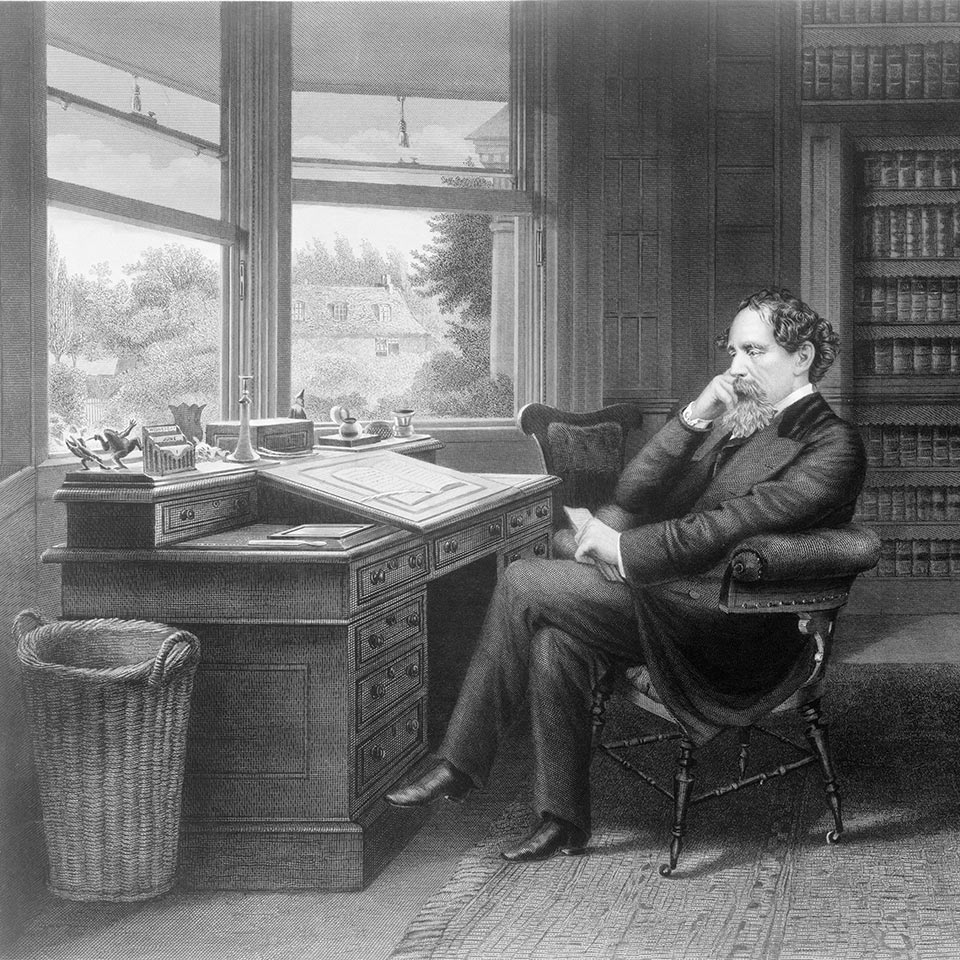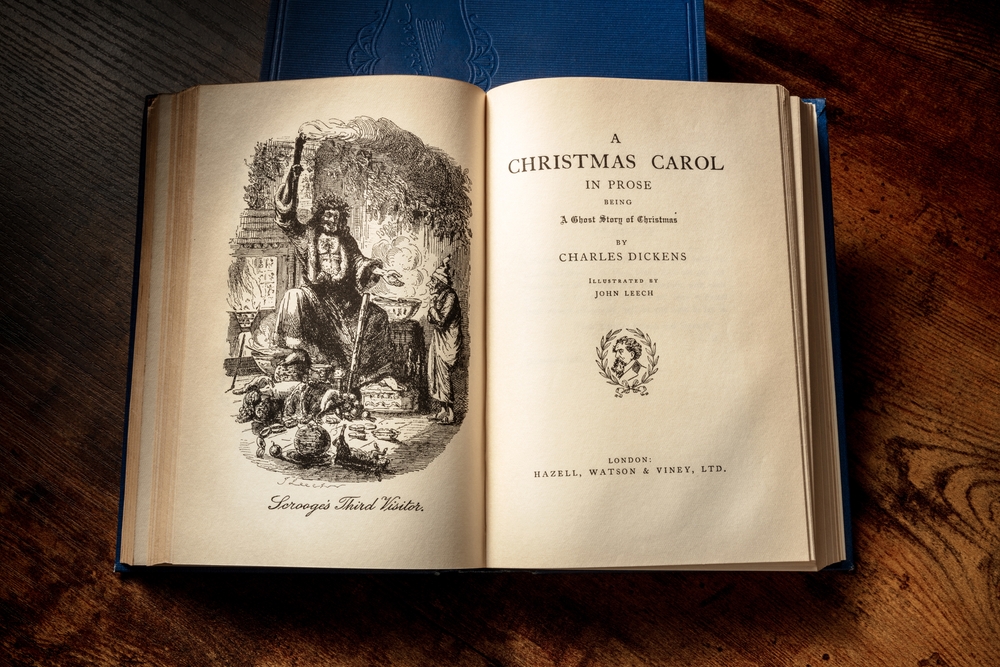With the release of our brand new History of Charles Dickens course, we thought it was high time to revisit the life and works of one of history’s best-loved authors: Charles Dickens. The most widely-read author of Victorian times, Dickens’ colourful characters, strong social conscience and ability to capture detail have fascinated readers for decades. Join us now for a whistle-stop tour through his life.
Jump to:

A Short Biography of Charles Dickens
Charles John Huffman Dickens was born in 1812 in Portsmouth, England. His father worked as a naval clerk and had a tendency to live beyond his means, leading to periods of financial instability for the family (and his eventual imprisonment for debt). As a child, Dickens was forced to leave school and work in a factory due to his family's financial troubles. This experience exposed him to the grim realities of child labour. This part of his life would go on to greatly influence his writing, making him the foremost voice of the working classes in his age.
Dickens left the factory at age 15 and became a law clerk, then a court reporter (working in shorthand), and then a parliamentary/newspaper reporter. Eventually, this career path led him to pursue his passion for writing. His first successful novel was The Pickwick Papers, published in serial form in 1836. This established his popularity, and he went on to produce numerous other classics like Oliver Twist, A Christmas Carol, and Great Expectations.
Dickens had a busy family life and fathered 10 children with his wife Catherine (married in April 1836). He travelled extensively, giving public readings of his work in Britain and America. His novels often critiqued social injustices like poverty, child labour, and inadequate public institutions. Dickens died in 1870, aged 58, leaving behind an incredible literary legacy.
Recommended for you!
Best Sellers10 Interesting Facts About Charles Dickens
Where Did Charles Dickens Live?
The Dickens family moved to London for 2 years in 1814, before relocating to Kent. It was here that Charles Dickens spent most of his early childhood. Due to their financial problems, the Dickens family moved back to London in 1822, where they settled in Camden town. He stayed in London throughout his adult life, living at Furnival’s Inn, 48 Doughty Street (now the site of the Charles Dickens museum), Devonshire Terrace and Tavistock House. For the last 14 years of his life, he lived at Gad’s Hill Place, Kent: curiously, this was the only house he had ever owned.
How Many Books Did Charles Dickens Write?
Dickens wrote a total of 15 major novels (often released in serial form), as well as 5 further novellas and numerous other short stories and essays.
What Was Charles Dickens Nickname?
When Dickens first began submitting work to newspapers and journals, he did so under the pseudonym “Boz”. Later, the word “Inimitable” was often added to this. Dickens had received greater acclaim during his lifetime than any previous author, so he was viewed as being in a class of his own! He was also sometimes referred to as “The Sparkler of Albion” (referencing his dazzling energy when it came to public speaking), and other names that paid homage to his dynamic speaking skills.
What Was Charles Dickens’ Style Of Writing?
Dickens’ writing style tended to include vivid descriptions that used very sensory language, as well as highly-memorable and descriptive character names. He made great use of first-person narration, as well as tremendous satire and humour. He also utilised emotive themes like the human condition, love, sacrifice, hope and redemption, and provided robust social commentary that addressed injustices in society, poverty, class differences and abuse of power in his native 19th century. Because his novels were published episodically, he often created additional suspense at the end of his chapters by using cliffhanger endings.
What Were Charles Dickens' Views On Poverty?
Having experienced poverty and financial hardship first hand, Charles Dickens was a compassionate and fierce campaigner against it. He felt that society and the government could and should do more to alleviate the harshest conditions of the underprivileged. Throughout his life, he criticised the inequalities between rich and poor, condemned laws that disadvantaged the poor, fought against child labour, and advocated for social reform. Although he valued self-reliance, Dickens believed that the poor deserve both dignity and opportunities to advance their prospects, and his writing aimed to generate empathy for their plight.
Which US President Did Charles Dickens Meet?
Dickens met John Tyler, the tenth president of the United States, at the White House, where the latter expressed astonishment at the former’s youth. The story goes that Dickens thought of returning the compliment, but restrained himself when he saw how very tired Tyler looked! He also met John Quincy Adams, the sixth president of the US.
What Was The Name Of Charles Dickens’ Sister Who Died?
Frances Elizabeth (Fanny) Dickens was the elder sister of Charles Dickens. Her son, Henry Jr, was said to be the inspiration for the character of Tiny Tim in A Christmas Carol. She died following complications caused by tuberculosis in 1848. Dickens’ sister-in-law, Mary Hogarth, also died suddenly at the age of 17. Mary lived with Dickens and her sister Catherine for a year, and their first daughter was named “Mary” in her memory. Her death caused Dickens to miss his publishing date for two novels.
Who Is The Protagonist And Narrator Of Charles Dickens’ Great Expectations?
Great Expectations’ protagonist and narrator is Philip “Pip” Pirrip, one of the most popular characters in English literature. The narrative is told entirely from the adult Pip's perspective, as he looks back on his early life and experiences. His character development reveals much about social class and ambition in 19th century England.

Why Did Charles Dickens Write A Christmas Carol?
Charles Dickens wrote A Christmas Carol as a social commentary that criticised greed and sought to bring attention to the plight of the poor and child labour issues in Victorian England. Scrooge’s redemption highlights the gap between rich and poor. Dickens was short on funds himself in 1843 too, so was aiming to quickly generate some much-needed income. It also served as an attempt to revive some (at the time sidelined) Christmas traditions, and experiment with supernatural themes.
How/Where Did Charles Dickens Die, And Where Is He Buried?
Dickens died of a stroke at his home at Gad's Hill Place on June 9, 1870. His wish was to be buried in Rochester Cathedral, but he was instead laid to rest in the Poets' Corner of Westminster Abbey. The inscription on his tomb reads:
"He was a sympathiser to the poor, the suffering, and the oppressed; and by his death, one of England's greatest writers is lost to the world."
What Are The 15 Charles Dickens Novels?
Here is a list of the major novels of Charles Dickens in chronological order:
- The Pickwick Papers (1836) - The adventures of members of the Pickwick Club as they travel around England getting into humorous scrapes and meeting eccentric characters.
- Oliver Twist (1838) - The story of an orphan boy who lives in a workhouse and becomes involved with a gang of thieves in London.
- Nicholas Nickleby (1839) - Nicholas and his family go through many trials and tribulations after his father dies and leaves them penniless.
- The Old Curiosity Shop (1841) - A young girl named Nell and her grandfather flee London and a villain who wants their fortune.
- Barnaby Rudge (1841) - A historical novel set during the anti-Catholic Gordon Riots in London in 1780.
- A Christmas Carol (1843) - Ebenezer Scrooge is visited by ghosts of Christmas past, present, and future one Christmas Eve.
- Martin Chuzzlewit (1844) - Martin falls out with his grandfather and travels to America to seek his fortune.
- Dombey and Son (1848) - The fortunes of a proud London merchant who neglects his family for the sake of his business.
- David Copperfield (1850) - Semi-autobiographical novel following David Copperfield's life from childhood to maturity.
- Bleak House (1853) - Legal drama revolving around the endless court case of Jarndyce and Jarndyce.
- Hard Times (1854) - Critique of industrialisation set in the fictitious Coketown.
- Little Dorrit (1857) - Satire on government bureaucracy portrayed through the fortunes of William Dorrit.
- A Tale of Two Cities (1859) - Historical novel set during the French Revolution featuring the famous opening line "It was the best of times, it was the worst of times."
- Great Expectations (1861) - Orphan Pip aims to improve his social status after getting support from an anonymous benefactor.
- Our Mutual Friend (1865) - Satirical portrait of Victorian society revolving around the inheritance of a dust-heaps fortune.
Of course, these 15 novels don’t form the entirety of Dickens’ prolific output. Some other notable examples are Sketches by Boz (1836), A Child's History of England (1851-1853), and The Life of Our Lord (1846), as well as The Mystery of Edwin Drood: the final novel written by Dickens, and the one that he never competed before his death.
Charles Dickens Quotes
Dickens’ writings brought about too many memorable quotes to name, but here are a few of our favourites:
"A day wasted on others is not wasted on one's self."
"No one is useless in this world who lightens the burdens of another."
"Have a heart that never hardens, and a temper that never tires, and a touch that never hurts."
"Reflect upon your present blessings, of which every man has plenty; not on your past misfortunes, of which all men have some."
"Heaven knows we need never be ashamed of our tears, for they are rain upon the blinding dust of earth, overlying our hard hearts."
"I have been bent and broken, but - I hope - into a better shape."
"There are dark shadows on the earth, but its lights are stronger in the contrast."
"A loving heart is the truest wisdom."
"We forge the chains we wear in life."
If you’d like to find out more about all things Dickens and Victorian, then our History of Charles Dickens course is an invaluable resource, immersing you in the life, works and societal impact of this literary giant. Enroll today for just £29 (saving £98) and learn more about this fascinating author.












